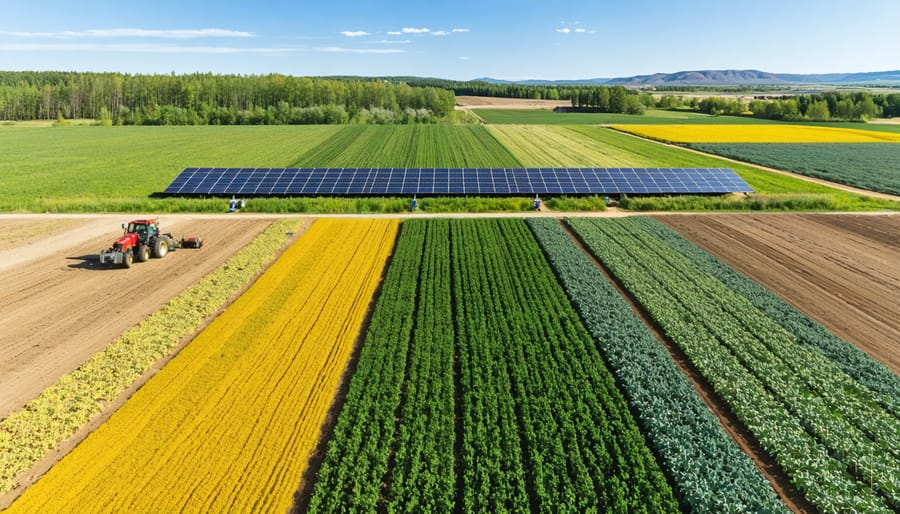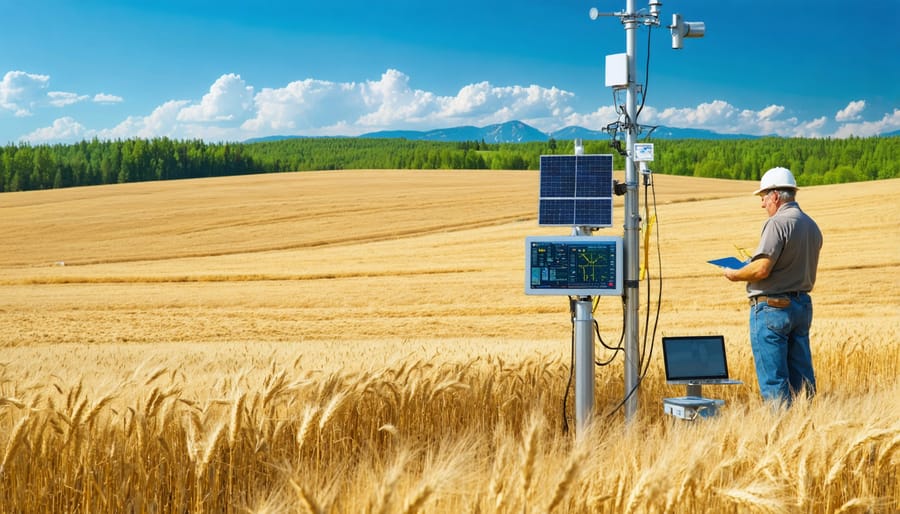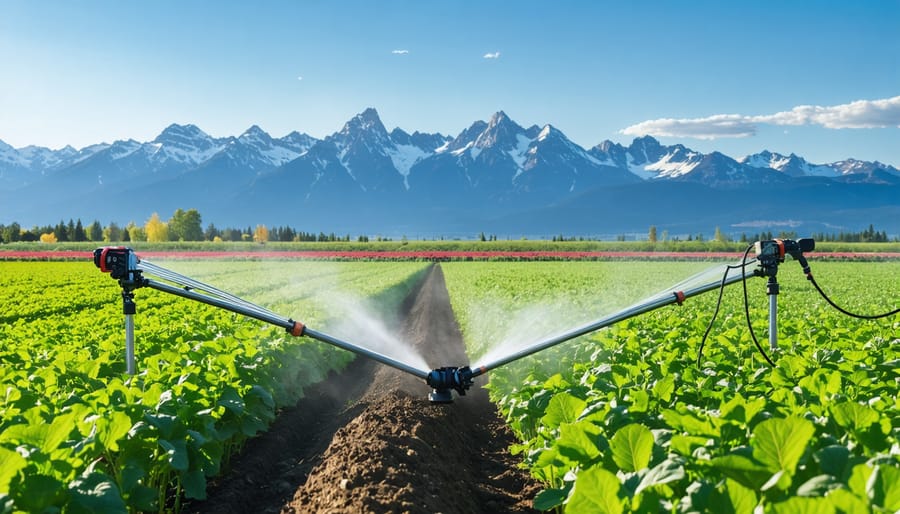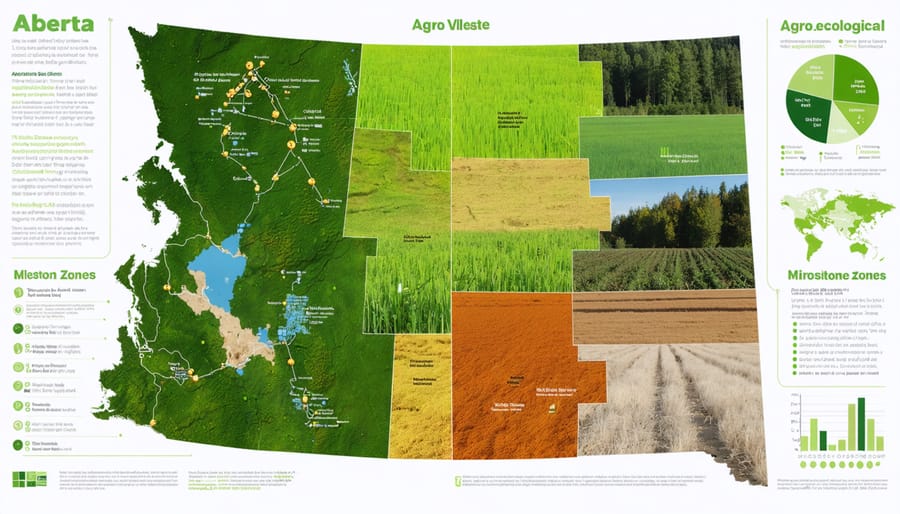Alberta farmers are pioneering climate-smart agriculture practices that simultaneously boost crop resilience and reduce environmental impact. By integrating traditional knowledge with cutting-edge innovation, these methods are transforming how we approach food production in an era of climate uncertainty.
Across the province’s diverse growing regions, from Peace Country’s northern fields to Medicine Hat’s semi-arid zones, producers are adopting precision irrigation systems, implementing zero-till practices, and diversifying crop rotations to build soil health while capturing carbon. These adaptive strategies not only protect against increasingly volatile weather patterns but also strengthen farm profitability through reduced input costs and improved yield stability.
The shift toward climate-smart agriculture isn’t just about environmental stewardship – it’s about securing the future of farming in Alberta. As extreme weather events become more frequent, these practices offer a practical pathway to maintain productive, profitable operations while contributing to climate change mitigation. Through collaborative efforts between farmers, researchers, and agricultural organizations, Alberta is emerging as a leader in sustainable agricultural innovation, demonstrating how local solutions can address global challenges.
This practical approach to climate-smart farming combines immediate economic benefits with long-term environmental sustainability, creating a resilient agricultural system that’s prepared for tomorrow’s challenges while meeting today’s needs.
Alberta’s Climate Reality: Why Traditional Organic Methods Need an Upgrade
Regional Climate Trends Affecting Organic Farms
Recent data from Environment Canada shows significant shifts in Alberta’s weather patterns, with increasing frequency of extreme events affecting organic farming operations. Over the past decade, our province has experienced a 1.4°C increase in average temperatures, coupled with more erratic precipitation patterns. These current climate challenges are particularly impacting spring planting schedules and harvest windows.
Southern Alberta has seen a 15% reduction in consistent rainfall during critical growing periods, while central regions report more intense but less frequent precipitation events. This shift has led to longer dry spells interrupted by heavy downpours, challenging traditional organic farming practices.
For organic producers, these changes have resulted in adjusted growing seasons, with spring activities starting approximately 7-10 days earlier than a decade ago. Northern regions are experiencing extended frost-free periods, opening possibilities for new crop varieties while also introducing risks from emerging pests and diseases that previously couldn’t survive our winters.
Understanding these regional trends is crucial for developing effective adaptation strategies and maintaining productive organic operations across the province.
The Cost of Inaction
The financial impact of delaying climate-smart agriculture adoption extends beyond immediate crop losses. Alberta farmers who maintain conventional practices face increasing risks of reduced yield stability, with recent data showing up to 30% yield variations during extreme weather events. These fluctuations can translate to an average revenue loss of $50,000 to $75,000 per growing season for a medium-sized farm.
Insurance premiums are also rising for farms without adaptive measures, with some Alberta producers reporting 15-20% increases in the past three years. Soil degradation from traditional practices costs Canadian farmers approximately $3 billion annually through decreased fertility and increased input requirements.
Beyond direct farm impacts, market access is becoming increasingly tied to sustainable practices. Major grain buyers and food processors are establishing sustainability requirements, with some offering premium prices for climate-smart products. Farmers who don’t adapt risk losing these valuable market opportunities and facing reduced competitiveness in both domestic and international markets.
The good news is that initial investments in climate-smart practices typically pay for themselves within 2-5 years through reduced input costs and improved crop resilience. Early adopters in Alberta report saving an average of 20% on water and fertilizer expenses while maintaining or improving yields.
Climate-Smart Solutions That Work in Alberta
Water-Wise Organic Farming
In Alberta’s semi-arid climate, water conservation is crucial for organic farming success. Local farmer Sarah Thompson from Lethbridge demonstrates how implementing drip irrigation has reduced her water usage by 40% while maintaining crop yields. This precision system delivers water directly to plant roots, minimizing evaporation and runoff.
Cover cropping has proven particularly effective in our prairie conditions. Using drought-resistant varieties like fall rye and clover helps retain soil moisture during dry spells while improving organic matter content. Many Alberta farmers report saving up to 25% in irrigation needs after establishing consistent cover crop rotations.
Mulching with locally sourced materials like straw or composted manure creates a protective layer that reduces evaporation and maintains soil temperature. Research at the University of Alberta shows that organic mulching can reduce water requirements by up to 30% in vegetable crops.
Timing is everything when it comes to water-wise farming. Early morning or evening irrigation maximizes water uptake and minimizes losses to evaporation. Installing soil moisture sensors helps determine precise irrigation needs, preventing both under and over-watering.
For small-scale operations, rainwater harvesting systems can supplement irrigation needs. Calgary-area farmer Mike Peterson collects approximately 50,000 litres annually from his barn roof alone, providing critical backup during dry periods.
Remember to regularly maintain irrigation systems and check for leaks – even small improvements in efficiency can lead to significant water savings over a growing season.
Soil Health Enhancement Strategies
In Alberta’s diverse agricultural landscape, building resilient soil systems is fundamental to successful climate-smart farming. Start with regular soil testing to understand your baseline and track improvements. Implement crop rotation cycles that include nitrogen-fixing legumes like field peas or faba beans, which naturally enrich soil while providing marketable crops.
Cover cropping between main growing seasons protects and enhances soil structure. Consider cold-hardy varieties like fall rye or winter wheat, which thrive in our prairie climate while preventing erosion and building organic matter. Many Alberta farmers have found success with cocktail cover crops, combining multiple species for maximum soil benefits.
Minimize tillage operations to preserve soil structure and beneficial microorganisms. When possible, leave crop residue on fields to decompose naturally, adding valuable organic matter and protecting soil from extreme weather events. Adding composted manure or other organic amendments can boost soil biology and water retention capacity.
Maintain living roots in the soil as long as possible throughout the year. This practice supports mycorrhizal fungi networks, which improve nutrient cycling and soil aggregation. Consider establishing windbreaks or shelterbelts, which not only protect against wind erosion but also contribute to soil organic matter through leaf litter and root systems.
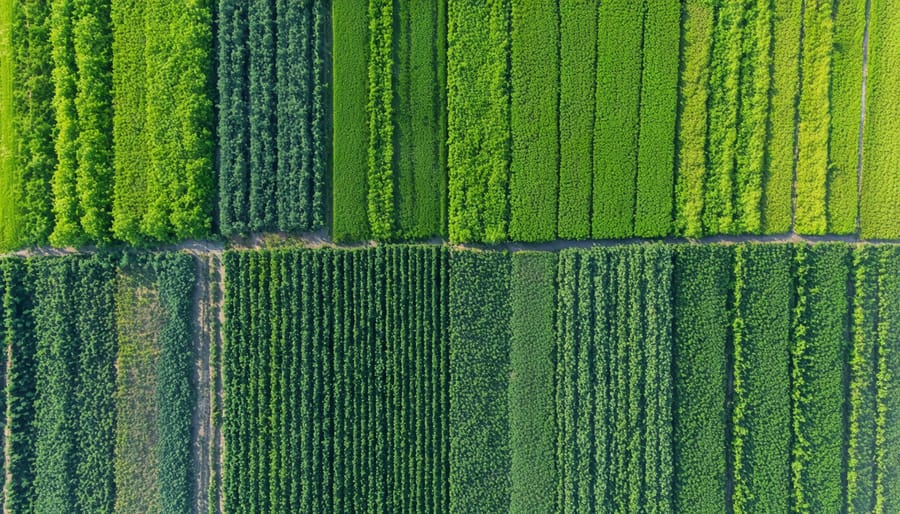
Crop Diversification and Rotation
In Alberta’s changing climate, implementing effective smart crop selection and rotation strategies has become essential for farm resilience. By diversifying crops and planning thoughtful rotation cycles, farmers can better manage risk while improving soil health and productivity.
Consider rotating between cereals, legumes, and oilseeds over a 3-4 year cycle. For example, following canola with wheat, then field peas can help break disease cycles while enhancing soil nitrogen levels naturally. Including cover crops like clover or rye during shoulder seasons provides additional soil protection and organic matter.
Local success stories show the benefits of this approach. The Peterson family farm near Red Deer increased their drought resistance by incorporating drought-tolerant pulse crops into their rotation, while maintaining profitable yields during challenging seasons. They’ve found that mixing short and long-season crops helps spread out both workload and weather-related risks.
When planning your rotation, consider:
– Moisture requirements of different crops
– Root depth variations
– Nutrient needs and contributions
– Local market opportunities
– Disease resistance
– Frost tolerance
Remember to adjust your rotation strategy based on soil testing results and seasonal forecasts. Working with neighbouring farmers to coordinate crop varieties can also help manage pest pressures across the wider community.
Advanced Weather Monitoring Systems
Modern weather monitoring systems have become essential tools for Alberta farmers adapting to our changing climate. These systems combine ground-based sensors, satellite data, and advanced analytics to provide precise, farm-specific weather insights that help inform critical decisions throughout the growing season.
Local farmers are increasingly installing smart weather stations that measure rainfall, soil moisture, temperature, wind speed, and humidity. These stations, typically costing between $2,000 and $5,000, can send real-time data directly to smartphones, allowing for immediate response to weather events. Many Alberta producers have found that these systems pay for themselves within two seasons through improved resource management and reduced crop losses.
The Alberta Climate Information Service (ACIS) network complements on-farm systems by providing regional weather data through over 350 monitoring stations across the province. By combining local and regional data, farmers can better predict frost risks, plan irrigation schedules, and optimize timing for seeding and harvest operations.
Recent innovations include soil probes that measure moisture at different depths and pest monitoring systems that correlate weather patterns with potential disease outbreaks. The University of Alberta’s Agriculture Research Station has demonstrated that farms using these integrated monitoring systems typically reduce water usage by 20-30% while maintaining or improving yields.
Remember, the most effective approach is to start with basic monitoring equipment and gradually expand based on your farm’s specific needs and challenges.
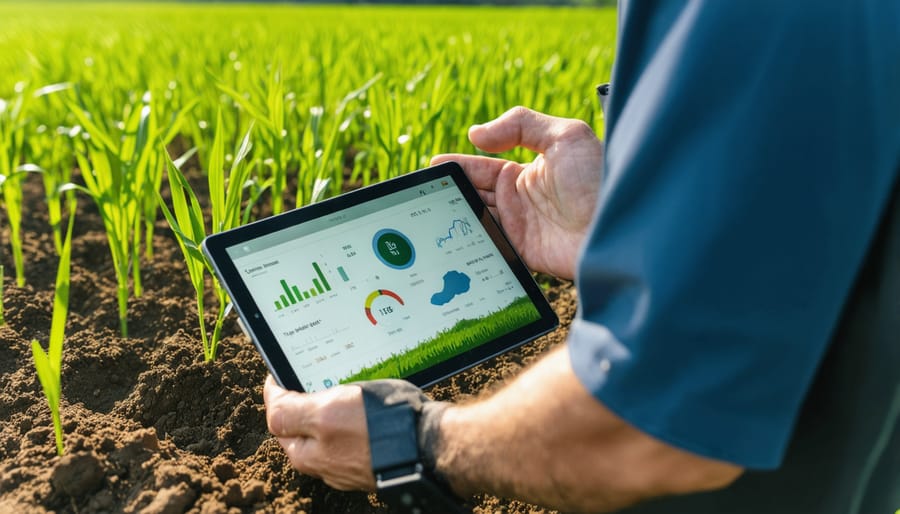
Real Success Stories: Alberta Farmers Leading the Way
The Thompson Family Farm Transformation
In 2018, Sarah and Mark Thompson faced a crucial decision on their third-generation farm near Olds, Alberta. Their 400-hectare operation was experiencing declining yields and increasing input costs, prompting them to explore climate-smart agriculture practices. Their three-year transformation journey offers valuable insights for Alberta farmers considering similar changes.
The Thompsons began by implementing reduced tillage practices and introducing cover crops, primarily using a mix of fall rye and field peas. Within the first year, they noticed improved soil moisture retention and reduced wind erosion across their fields. Their soil organic matter increased from 2.3% to 3.1% over two years.
“The biggest game-changer was our transition to precision agriculture,” explains Sarah Thompson. “We invested in GPS-guided equipment and variable rate technology, which helped us reduce our fertilizer use by 20% while maintaining yields.” The family also installed soil moisture sensors across their property, enabling data-driven irrigation decisions that cut water usage by 25%.
The Thompsons didn’t make these changes alone. They participated in local farmer-led research groups and worked closely with agriculture extension specialists from Olds College. Through cost-sharing programs, they offset 30% of their initial technology investments.
Today, the Thompson farm serves as a demonstration site for climate-smart practices. Their annual field days attract dozens of local farmers eager to learn from their experience. “The transformation wasn’t always easy,” Mark reflects, “but our operating costs are down, our soil is healthier, and we’re better prepared for extreme weather events. Most importantly, we’re building a more resilient farm for the next generation.”

Collective Action: The Red Deer Valley Initiative
In 2018, a group of Red Deer Valley farmers faced increasingly unpredictable weather patterns that threatened their crop yields. Rather than tackle these challenges individually, 47 local farming families joined forces to create the Red Deer Valley Initiative, demonstrating the power of collective action in implementing climate-smart agriculture practices.
The initiative began with monthly meetings at the local community center, where farmers shared their experiences and knowledge. Together, they developed a collaborative approach to water management, including the creation of a shared irrigation schedule and the implementation of soil moisture monitoring systems across multiple properties.
“We realized that what affects one farm affects us all,” explains Sarah Thompson, a third-generation farmer and initiative coordinator. “By working together, we’ve been able to implement changes that would have been too costly or complex for individual farms to manage alone.”
The group’s achievements include establishing a seed-sharing program for drought-resistant crop varieties, developing a community-owned composting facility, and creating a regional weather monitoring network. Their collective purchasing power also enabled them to invest in advanced irrigation technology, reducing water usage by 30% across participating farms.
The initiative’s success has inspired neighbouring communities, with similar programs now emerging in other Alberta regions. The Red Deer Valley farmers continue to meet regularly, sharing data and adjusting their strategies based on collective learning. Their experience shows that community-based approaches to climate-smart agriculture not only improve environmental outcomes but also strengthen social bonds and economic resilience in rural communities.
Today, the initiative serves as a model for other farming communities looking to adapt to climate challenges while maintaining productive and sustainable agricultural operations.
As we’ve explored throughout this article, climate-smart agriculture offers practical solutions for Alberta farmers facing environmental challenges. By implementing these sustainable practices, you’re not just adapting to climate change – you’re actively contributing to a more resilient agricultural future for our province.
Remember that success in climate-smart farming doesn’t require an immediate overhaul of your entire operation. Start with small, manageable changes like introducing cover crops or testing reduced tillage in a single field. Monitor your results, connect with local farming groups, and gradually expand what works for your specific situation.
The Agriculture Financial Services Corporation and Alberta Agriculture and Forestry offer support programs to help offset the costs of transitioning to climate-smart practices. Your local agricultural extension office can provide guidance on available resources and connect you with experienced farmers who’ve successfully implemented these methods.
Looking ahead, the future of farming in Alberta depends on our collective ability to adapt and innovate. Whether you’re managing a large-scale operation or a small family farm, every step toward climate-smart agriculture matters. Consider joining a local sustainable agriculture network or attending workshops to stay informed about emerging practices and opportunities.
By working together and sharing our experiences, we can build a more sustainable and profitable agricultural sector that benefits our communities, our environment, and future generations of Canadian farmers.

